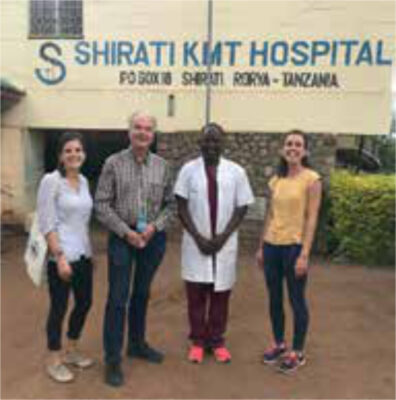Main content
This article is based on a series of interviews conducted in September 2020 on four subjects, each with separate involvement in the Shirati Research Centre in Tanzania.
In 2012, Dr. Bwire Chirangi returned from two years of living abroad in the Netherlands to start his position as medical director of the Shirati KMT Hospital. Having just completed his masters in public health at Maastricht University, Chirangi made the long trip back to the lakeside village of Shirati, in Northern Tanzania with a heightened perspective on global health, a refined understanding of what would be needed to establish and carry out meaningful research, and the seedlings of newly formed partnerships that would grow considerably in the years to come. Shirati, a lively town close to the Kenyan border, is home to the largest healthcare facility in Rorya District, the Shirati KMT Hospital. The catchment area of the hospital covers about 250,000 people, most of whom live in widespread rural villages scattered alongside Lake Victoria.[1]
In the time since his return, and with the help of the present head of operations, Nyamusi Magatti, Dr. Chirangi founded an adjoining research centre as part of the health promotion programme of the hospital. Although not yet operating at the capacity that Chirangi ultimately aspires for, the two have established firm collaborations with several universities around the world that have contributed to and supported an influx of several new research projects in the past years. “There were areas of research we wanted to continue (pursuing), and we thought students could help us with that, so it was in the interest of the local team”, Magatti explained about the start of the collaboration with student researchers. Chirangi and Magatti are striving to use existing partnerships to help expand the centre’s operational capacity, and in turn offer some lasting change to the community by improving health outcomes both within and beyond the hospital walls.

Challenges in performing research in rural Tanzania
Growing up with a father who was working on projects in AIDS and Burkitt’s Lymphoma, Mr. Magatti was no stranger to the world of research even before he took his current position. Magatti obtained a BSc in biology in the United States of America followed by a masters in global health in the Tanzanian capital, Dar es Salaam, before returning to Shirati where he was born and raised. There, he began to immerse himself in research projects that sought to better understand components of the poor health in the community around him, like the high prevalence of schistosomiasis and high maternal mortality. Numerous other illnesses – malaria, malnutrition, and HIV to name a few – are also extremely common within the Shirati catchment area, and are compounded by infrastructural limitations like poor road systems and lack of access to clean water.
“The high burden of disease in the region also offers new opportunities to do more research”, Dr. Chirangi says, speaking to some of Shirati’s challenges. Lieke Buijs is a medical student from Maastricht University who stayed in Shirati last fall to collect data on a project related to the double burden of malnutrition. Buijs’ passion for global health and interest in expanding her horizons beyond medicine in the Netherlands made her join the research project in Shirati. Buijs echoes Chirangi’s sentiment, acknowledging that while the prevailing disease and infrastructural aspects of the setting can be difficult, the high prevalence of some of these health conditions makes Shirati a good setting for research. “There are a lot of unknowns still, and not that much research has been done here previously.”
Buijs’ field supervisor, Global Health and Tropical Medicine Doctor-in-training Victoria von Salmuth, recalled local challenges that she encountered during her medical elective in Shirati in 2015. “I was struck by the numbers of children with acute and chronic malnutrition and the few treatment options we had access to.” Von Salmuth has since returned to Shirati multiple times, both to work as a doctor, and in cooperation with the Shirati Research Centre and Maastricht University to help establish the research project that Ms. Buijs is currently working on. “There were a lot of challenges we were faced with from the beginning”, Von Salmuth remembers of the first months on the ground. “There was a clear language barrier, as many people are speaking local languages in the region, and many cultural differences.”
Partnerships and the research centre
Mr. Magatti regards Shirati’s challenges as precisely why it is beneficial to have strong local partnerships on the ground. “You need the perspective from a local person; culture and language are usually a big barrier.” Together with a small team that is responsible for facilitating various forms of data collection in the surrounding communities, Magatti takes on several roles to ensure that studies remain operational and that the research remains viable. Magatti’s team has built up expertise on community relations, ever acknowledging the many points in the research and dissemination process where communication and acceptance are as essential as they are delicate. Composed of about ten people based in Shirati, the translators and research assistants that make up the team, some doubling as nurses in the hospital, are all trained and overseen by Dr. Chirangi and Mr. Magatti.
One particularly successful research project at the Shirati research centre that has exemplified what can be achieved through its strong partnerships is the Saving Mothers Project, established in 2012. [2] The success of this project has been a motivating factor for the centre to continue implementing large-scale studies. Together with partners from Innovating for Maternal and Child Health in Africa (IMCHA), they introduced a distribution system of birth kits to reduce the risk of postpartum haemorrhage and infections, examined barriers to antenatal care in rural healthcare facilities, and equipped community health care workers with a mobile health application that was shown to improve the tracking and registration of patients. [3]
Collaborations with international researchers and students
What started as a medical internship programme that Dr. Chirangi has worked to incrementally advance is now an ever-evolving international collaboration of doctors, students, researchers and global health professionals. In the years prior to the Covid-19 pandemic, Shirati was experiencing a continuously increasing influx of foreign-based research associates. In a typical year, between five and eight international research students come to Shirati to work on existing projects. Chirangi and Magatti both consider the cooperation with international universities as a valuable addition to their research endeavours: “For us it is really important to get different ideas and perspectives to improve our research projects, including new ideas from the students, to add some meat to the bone of our research”, Magatti explains.
Ms. Buijs reflected on how the Tanzanian based partners helped guide her through her own experience in Shirati, both in giving direction to the research itself and also in sharing essential knowledge on local needs and priorities. “Many discussions with the research team in Shirati helped to develop the scope of our research project further, influenced the methods used, and extended the subjects covered.” Buijs was able to draw from the wealth of experience and tailored community expertise that Chirangi and Magatti have harnessed through years of community based research.
Ms. von Salmuth noted the importance and the advantages of collaborating with locally based researchers, where a network of partnerships already built into the fabric of the research centre facilitates broad access to the community. “Personal relationships that have been built over years are the foundation of our project – they involve trust, mutual respect, and clear communication.”
Collaborations with local leaders and policy makers
For Chirangi and Magatti, valuable partnerships and collaborations are not merely between researchers, but also with governmental actors and local community leaders. Chirangi emphasizes the importance of involving all stakeholders from the very beginning in the process of setting up new research projects, including community leaders, policy makers and the government, to align research priorities. [2] “Start with an introduction to research, so that the community becomes familiar not only with the aim of the research but also the intended results”, Chirangi states. In his experience, making an effort to ensure that the community leaders understand why the research is being conducted can help to encourage the community to be more receptive not only to participating in a study but to proposed interventions upon the study’s conclusion. Dr. Chirangi also believes that disseminating the results of the research back to the community is vital and helps to build acceptance for the implementation of interventions. The results of the Saving Mothers study was presented back to the regional health management team and culminated in the use of safe birth kits being implemented in the Comprehensive Council Health Plan, which entails their distribution in all health care facilities in the Rorya district. As for the part of the project aimed at reducing the barrier of transportation, two villages have started community funding to support women financially to reach the nearest health facility. “This for me shows sustainable implementation and real community involvement”, Chirangi adds.
Mr. Magatti hopes to further collaborate with government actors in the future, but notes the difficulties in doing so. “Resources here are very limited; the government would love to get involved in research studies, but they have to choose their priorities. Even if you do want to invest in research, but at the same time no medication is available or medical staff, you have to make choices.” In a hierarchy of hospital needs, such choices will often defer to the latter. Therefore, the government encourages the public- private partnerships that the Shirati research centre has shaped, to fund what they cannot.
Funding, however, continues to pose a major challenge to the research projects in Shirati. “Funding is difficult to get, also due to Shirati’s location in a very rural part of Tanzania – far away from big cities and difficult to reach”, Chirangi states. The international collaborations have helped in attracting donors in the past, Chirangi notably mobilizing numerous global partners, such as UKAID and Grand Challenges Canada in the undertaking of the large scale Saving Mothers Project. “Partnerships have absolutely helped in moving closer to reaching our goals”, Magatti affirms.
Aspirations
Working tirelessly to oversee operations in the centre, Chirangi and Magatti have high hopes for the future of their research initiatives. Their dream is to expand their professional research centre in Shirati to one that eventually will attract more researchers and operate at a greater capacity. “A place where students, doctors, and people with different ideas from around the world can meet, exchange ideas, write proposals and apply for new funding, and where people of the community can start to understand that this research we are doing can have a big impact on them: this is the future”, Magatti says. “We can do research that can be an example for this area and that people can emulate; we can set an example for the region and the country.”
Going forward, Magatti and Chirangi are aiming at improving multi-sectoral collaborations with regional and international partners. Chirangi emphasizes that “different perspectives matter, especially when talking about new interventions”. He hopes to achieve this by creating more opportunities for foreign and local partners alike to get involved with the centre, and also by making living in the town more appealing to people from elsewhere in Tanzania and abroad, which would in turn gradually improve aspects of the local infrastructure. “And of course”, he adds smiling, “we want to keep our close ties with Maastricht University.”
The research team in front of the Shirati Hospital, Nov 2019. From left: Victoria von Salmuth, Onno van Schayck (Prof Maastricht University), Bwire Chirangi, Lieke Buijs
Personal profiles
Bwire Chirangi, MD, MPH
PhD candidate at Maastricht University, Medical Director of the Shirati KMT Hospital and principle investigator of a number of research projects
Nyamusi Magatti, Bsc, MSc
Coordinator of Research Centre in Shirati, Executive Director Shirati Health Education and Development Foundation (NGO)
Victoria von Salmuth, MD, MPH
Resident in Global Health and Tropical Medicine, PhD candidate Maastricht University, research coordinator project on malnutrition, Shirati
Lieke Buijs
Medical student at Maastricht University, research internship in Shirati, Tanzania

References
- The United Republic of Tanzania. 2012 population and housing census: population distribution by administrative areas [Internet]. Dar es Salaam, Zanzibar: National Bureau of Statistics, Ministry of Finance, Office of Chief Government Statistician President’s Office, Finance, Economy and Development Planning; 2013. 264 p. Available from: http://www.tzdpg.or.tz/fileadmin/documents/dpg_internal/dpg_working_groups_clusters/cluster_2/water/WSDP/Background_information/2012_Census_General_Report.pdf
- Webber G, Chirangi B, Women’s health in women’s hands: a pilot study assessing the feasibility of providing women with medications to reduce postpartum hemorrhage and sepsis in rural Tanzania. Health Care Women Int. 2014;35(7-9):758-70 DOI: 10.1080/07399332.2014.915843
- Webber G, Chirangi B, Magatti N. Community member and policy maker priorities in improving maternal health in rural Tanzania. Int J Gynecol Obstet. 2018 Apr;141(1):80-4. DOI: 10.1002/ijgo.12435.


















































